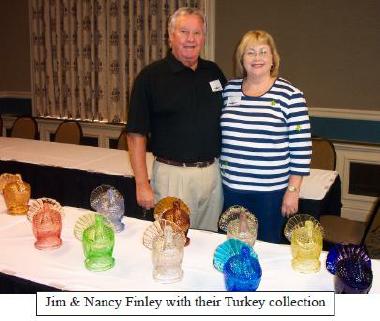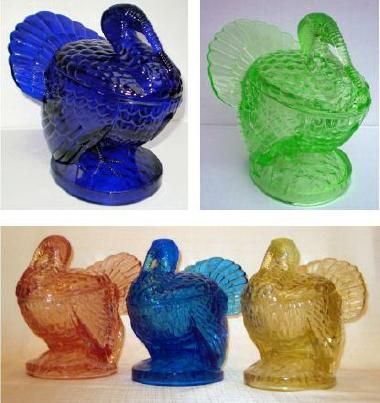Let's Talk Turkey
by Jim & Nancy Finley
Issue No. 425 - February 2009
TIME LINE/HISTORY: The first mention of the Cambridge
turkey is in "China Glass & Lamps" issue of December 1930. The
direct quote is: "Symbolic of the many live, quick-selling novelty
glassware items to be found in Cambridge displays in the life like
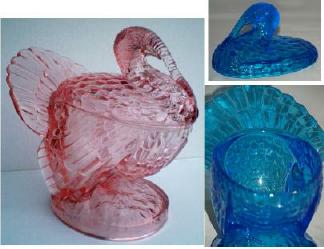 semblance of this Turkey - a striking container for candy, nuts and
sweetmeats. Finely executed, this Turkey container is a wonderful
novelty for Holiday selling. We are prepared to make immediate
shipment. Can be had in Gold Krystol, Peach-blo, Emerald, Amber,
Willow-blue and Crystal. It is item No. 1222."
semblance of this Turkey - a striking container for candy, nuts and
sweetmeats. Finely executed, this Turkey container is a wonderful
novelty for Holiday selling. We are prepared to make immediate
shipment. Can be had in Gold Krystol, Peach-blo, Emerald, Amber,
Willow-blue and Crystal. It is item No. 1222."
In addition to the above article the Turkey is pictured in the 1930-34 catalogue. Phyllis Smith wrote in the November 1987 Crystal Ball that the turkey mold was added to the WWII scrap iron drive in the very early 1940's. We can deduce that the Cambridge turkey was in production for at least 10 years.
PHYSICAL DIMENSIONS: About 9" tall from base to top of head, width of tail 6¾"-7", circumference of base 17", has 17 feathers on tail.
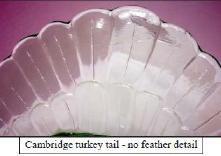 DESCRIPTION: (1) has no feather details. (2) no cross hatch on
base. (3) underside of base appears to be a leaf covered mound of
dirt. (4) the back has a sparse pattern of foliage with little leaf
DESCRIPTION: (1) has no feather details. (2) no cross hatch on
base. (3) underside of base appears to be a leaf covered mound of
dirt. (4) the back has a sparse pattern of foliage with little leaf
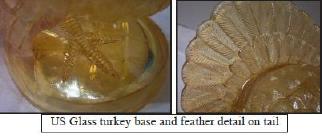 detail and design. (5) the Cambridge turkey slants slightly (back
to front).
detail and design. (5) the Cambridge turkey slants slightly (back
to front).
COLORS: In addition to the colors mentioned above, the company added: Royal Blue, Bluebell, Moonlight blue and frosted. There are also Charlton decorated turkeys. Other colors in production during the same time that the turkey was produced were Carmen, Ebony, Forest Green and Crown Tuscan. As collectors, we have no idea why the turkeys were not produced in these other colors too.
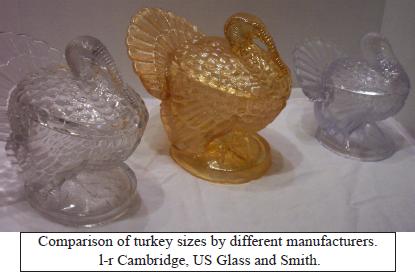 TURKEYS BY OTHER COMPANIES: US Glass made a turkey
that is very similar to the Cambridge turkey. It is slightly larger,
has a cross hatch on the base and has feather detail. It has been
suggested by Lynn Welker that Cambridge was inspired by this
turkey to produce the Cambridge candy box.
TURKEYS BY OTHER COMPANIES: US Glass made a turkey
that is very similar to the Cambridge turkey. It is slightly larger,
has a cross hatch on the base and has feather detail. It has been
suggested by Lynn Welker that Cambridge was inspired by this
turkey to produce the Cambridge candy box.
L. E. Smith is another company that makes a turkey. The Smith turkey is in production today and retails for $50.00 to $100.00 (the Cambridge turkey commands a much higher price tag!). The Smith turkey is smaller than the Cambridge one, has feather details and has pebbles on the base. The Smith turkey is being sold by Williams-Sonoma in crystal and sage green. Smith also supplies Martha Stewart in "Martha by Mail" in an opaque green and milk glass. Smith Glass sells (for themselves) crystal and amber.
The L.G. Wright turkey and a Czechoslovakian import are similar with feather detail and a waffle base.
IN CONCLUSION: The Cambridge Glass collector will be able to identify the Cambridge turkey by remembering these things: no feather detail on the tail and no cross hatch or waffling on the base. Happy hunting! We hope the pictures help.
